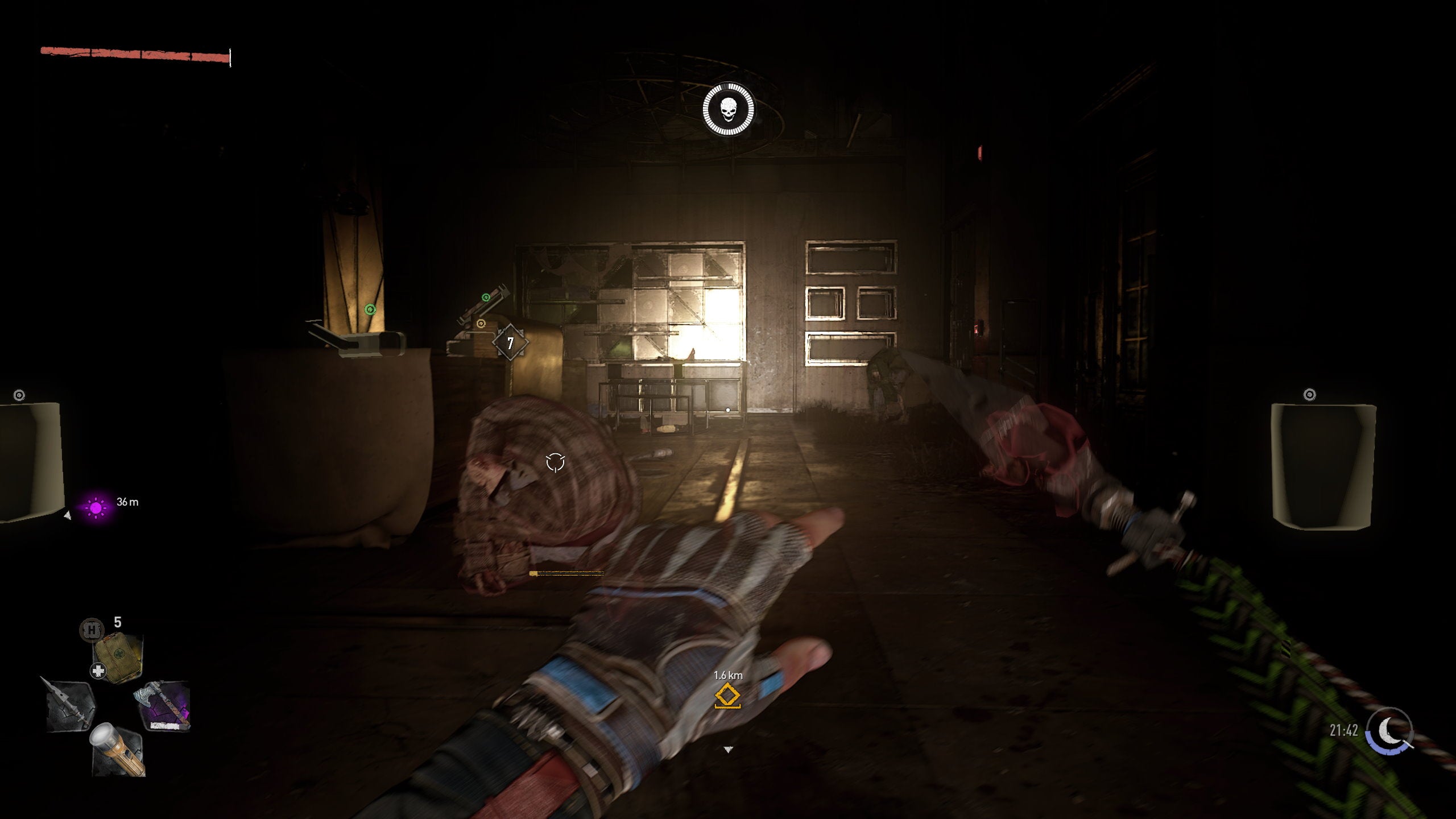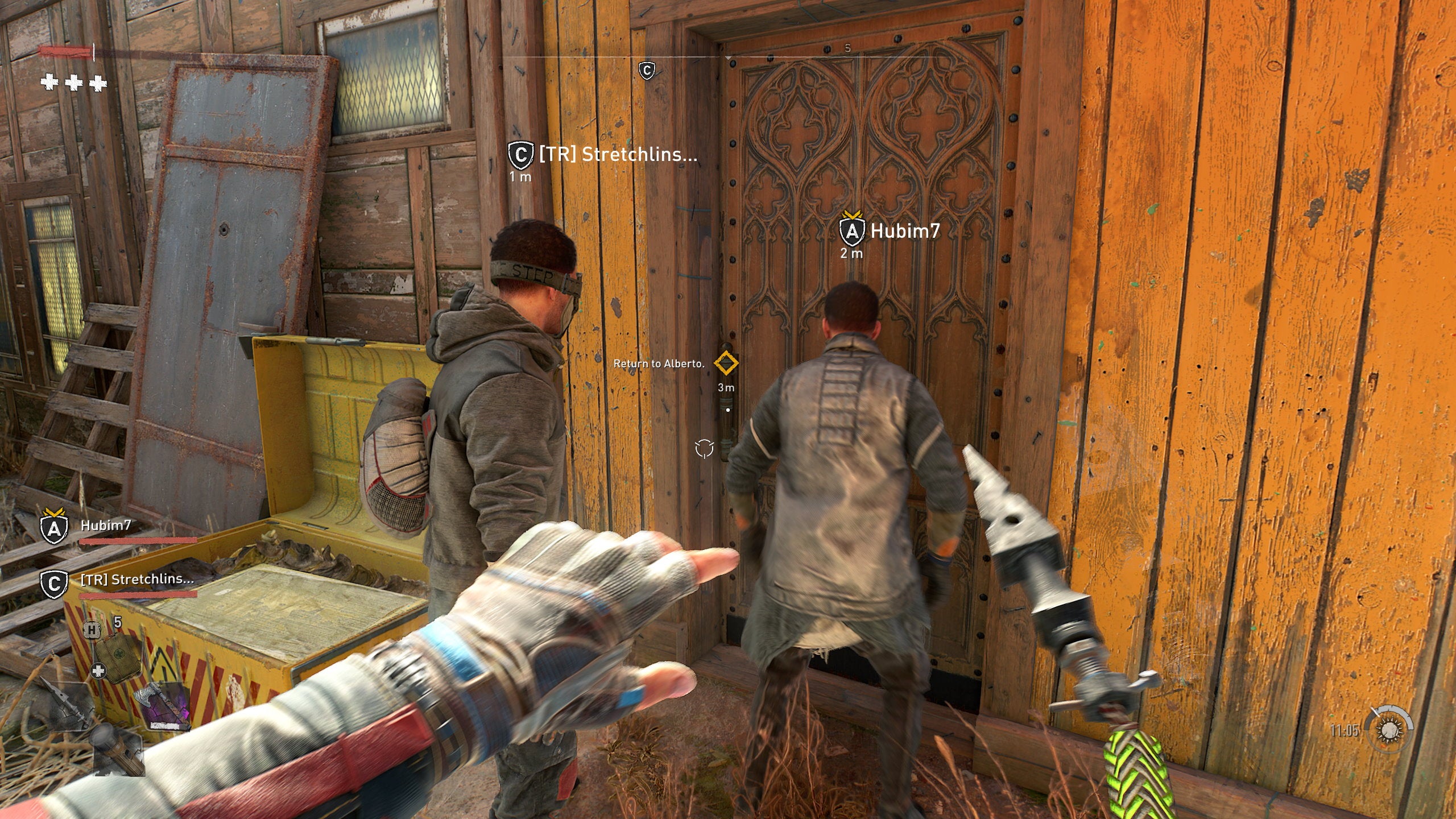You see, the original Dying Light was slow to the boil, the fun of its survival loop not fully emerging until you’d escaped the initial narrative funnelling and levelled up your arms to the point that parkour could get more expressive and the zombie-braining more excessive. Once you had a foothold in Harran, you could enjoy the game for what it was: an open world adventure about coming to terms with an unabating zombie threat. No easy fixes. No streets cleaned out or regions conquered; just the endless undead and a constant throb of danger to whatever task you set yourself that day. It felt pleasingly freeform and organic at a time when Ubisoft’s mania for stymying map icons was spreading like, well, a zombie plague.
Dying Light 2 is quicker to get moving. A prologue set outside the city - a linear mountain region reminiscent of the first game’s The Following expansion - establishes new hero Aiden as a more competent survivor, well versed in clambering and evasion before he sets foot in the streets of Villedor. First-person parkour feels lighter from the off, letting you cross larger gaps and throw Aiden around with some confidence. And where low-level combat in the original was mostly about stamina management as you breathlessly donked lead pipes off zombie skulls, the sequel mixes in parries, split-second dodges (complete with Bayonetta witch time, with the right upgrade) and the ability to vault over winded foes into a flying kick. These are showy flourishes of a power fantasy, rather than the panicked scrabble of the first game.
On one hand it readies you for a quest that is immediately gripping and able to throw daunting set pieces at you. Your arrival in Villedor, where proof of health hinges on a wrist-mounted biomarker that you don’t currently possess, drops you into a thrilling dash through the night and a den of hospital-dwelling infected that feels as high stakes and disorientating as Dying Light 1 at its best. But I definitely miss the sensation of a fighter slowly emerging from a jumble of awkward limbs that gave the original its power curve, and the first act feels one note as a result. For all the big talk of how outsiders aren’t ready for city life, Aiden takes it in his roof-hopping stride. The church spire no local dare climb? Up there in seconds. That wind turbine base that has everyone spooked? Nothing a few drop kicks can’t fix. It has weirdly low stakes for what the devs have talked up as a brutal ‘modern dark ages’.
This is compounded by Dying Light 2’s major misstep: the decision to split zombie behaviour over the day and night cycle. UV rays are (re)death to the infected, so only the most dessicated leftovers venture out into the sunlit streets, in turn rendering the dark interiors as impassable zombie nests. Come nighttime, this flips, flooding the streets with ferocious variants (the mix getting spicier as the story progresses) and granting an opportunity to sneak into now-emptied buildings to pillage wares.
As a concept, I get it: the original game always struggled to draw explorers out at night as the streets were patrolled by ‘volatiles’ - seven foot brutes who burned bright orange like Morph on ‘roids and were so effin’ tough that most people just slept the night away in a safe house rather than risk getting ganked by the Tango Man. This time, there are tangible nighttime rewards in revisiting the interiors you clocked during the day, and gentler punishments for getting caught. If a howling alarm zombie spots you it triggers a chase of regular biters that only scales up to volatiles if you fail to lose your pursuers, and which ends when you reach a UV safe spot, of which there are plenty. As a result, nights feel safer, and there’s less of the stop/start that defined the first game’s day cycle.
But! In doing so, it robs the zombie apocalypse of any urgency, imbuing the horde with a fatal predictability. In daytime the threat is naturally low, to the point where you can run through the streets - or even straight through the zombies with an unlockable move where you dash with your hands across your face, like your mum escaping a wasp in a pub garden. Come night, you simply avoid the horde by sticking to the rooftops or ducking indoors where the few remaining zombies are now asleep. Interiors are barebones stealth sections, with all too obvious routes to sneak by sleepers and an all too effective neck snap should one block the path. The end result is that you spend a lot of the game being shepherded towards the least interesting place at any given time. Empty streets or empty buildings: which is to be?
Not to keep banging the Dying Light 1 drum, but there the creatures were always up in your face, a low level threat that could escalate into a high level threat because you accidentally made too much noise and drew a crowd or missed yourself getting surrounded - y’know, the classic zombie movie tropes you’ve always wanted to experience. Dying Light 2 is so easy to cheese by comparison I found it powerfully unthreatening, and with that comes a diminishment of everything: the excitement of a new power, a new weapon, a new anything. Hey, it’s great that juicing up the electrical station has inspired the army faction to install spiked pendulums across the city, but I was doing just fine without them, thanks.
This isn’t to say that Dying Light 2 is a massive bust - ironically, I think the general ease of day-to-day life will probably resonate with plenty of people who just want to clear a Far Cry-style map without meeting anything scary. Certainly, the sequel is neater in this sense, with more icons to tick off than the first game. There are mini bosses to hunt, special upgrade containers to sniff out, windmills that act like Far Cry radio towers and actual radio towers that are Far Cry radio towers. In Dying Light 1 you climbed up to high places because it made sense as the best way to survey the city and plan your time. Here it’s decreed.
I wish you could dial down the pointers and hand holding. You can turn off enemy health bars, which adds a frisson of unknowability. But it could offer more. Take, for example, how the map says whether you have the right stamina level to climb a tower. Why? Let me try and screw up for myself. Let me struggle to scale it - or better yet, find an alternate solution the designer didn’t predict - and claim the eventual victory more organically. And why flag every resource-rich interior on the map, when in the original game I was quite capable of sniffing out doors for myself. Let us put one and one together and work out that a pharmacy might be worth scoping out at night, rather than dotting it on the map - and worse, with an icon that can never be removed because the locations eventually restock. Yes; it’s a map icon game where you can’t clear the map icons! What fresh hell is this?
I realise I’m veering into reviewing what I want it to be, rather than what Dying Light 2 is. And to be fair, around its low pressure centre lurk some entertaining distractions. Drop kicking bandits off 30-storey buildings tickles the same ‘physics thug’ part of the brain left untouched since Dark Messiah. Modding a katana so it belches flames adds insult to injury. And the decision to hold back the new paraglider and returning grappling hook until the second act is exactly the kind of delayed gratification I loved the first time round. Arriving just as you’re feeling comfortable with parkour, the glider basically rules out dealing with the streets ever again: terrible news for the already weedy zombie threat, but a fantastic way to take in the skyscrapers of Villedor’s financial district.
Up there Dying Light 2 becomes what I wanted Mirror’s Edge Catalyst to be. An endless succession of heart-in-mouth stunts as the grappling hook swings you over the abyss and straight into a roly-poly before you’re back into a sprint with no loss of speed. When Aiden gets going, he really gets going, even at a thousand feet. Special nod to composer Olivier Deriviere’s propulsive score which accompanies your vertiginous climbs - it drives you forward with daredevil momentum and a neat audio effect that sounds like the soundtrack is holding its breath whenever you do something scary.
Though even this pocket of delirium is eventually nuked, with a baffling story decision that floods the prettiest view of the city with a dense fog. I think it’s meant to demonstrate the game’s commitment to world-altering choice and consequence, but defacing the best-looking area of Villedor seems like vandalism. More successful is a late game choice that potentially adds an entire region to the map - I know that guides wizard Olly didn’t see it in his playthrough, and the autosaving means you can’t save scum to a happier outcome. It also makes it hard to test far reaching consequences without a total replay, though talking with other reviewers it sounds like choices are honoured throughout, even if the Aiden’s bland story is largely immutable. He’s heading in one direction whether you like it or not, so the real treasure is the NPCs that got bludgeoned along the way.
I’m glad it wasn’t 500 hours long. As a freelancer that would work out at about 30p an hour, but, more pertinent to you, there’s just not enough character to Dying Light 2 to hold your attention beyond a fleet-footed 30. Techland’s taken something quite distinct and sanded down the edges. Some will find it agreeably smooth, I’m sure, but you can only sand so much off of chaos before it becomes ordinary. Come the real zombie apocalypse we should all be so lucky to face a world this trudgingly well behaved.




